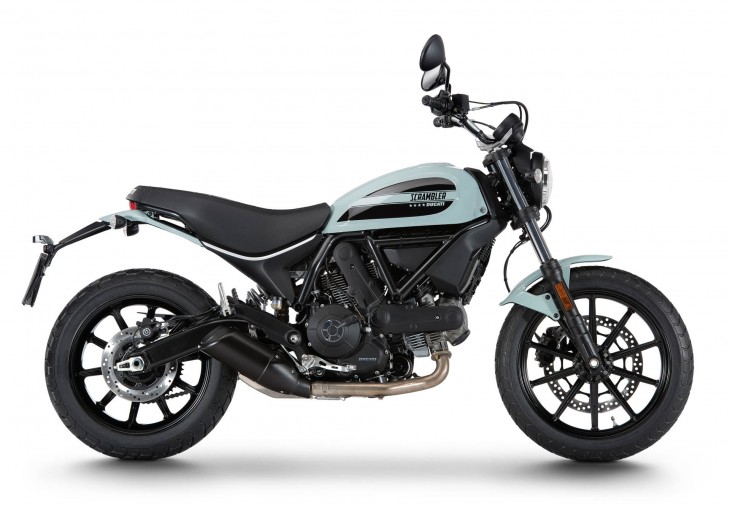Ducati Unveils New Scrambler Sixty2 – 399 cc Twin (updated)
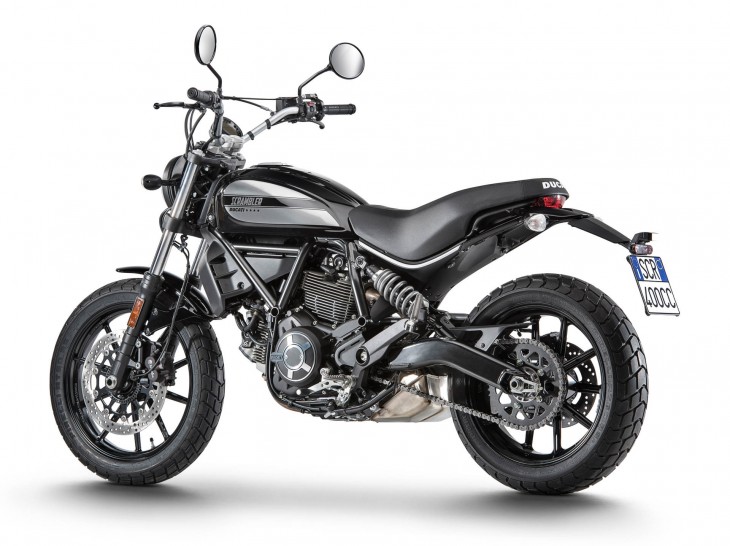
This is the new Ducati Scrambler Sixty2 with which the brand intends to expand its Scrambler family with a low cost, entry level bike. Featuring a 399 cc twin-cylinder engine rated at 41 hp, the Sixty2 is no lightweight … curb weight is roughly 400 pounds. We do not know any details regarding U.S. pricing or availability at this point. Here is what Ducati has to say about the new Scrambler Sixty2 (you can see full specs here):
New Pop Icon
The new Ducati Scrambler Sixty2 doesn’t just extend the range on offer from the new Ducati brand. It opens the way for a new two-wheel segment that meets the requirements of those seeking an accessible bike that is easy to handle and has low running costs but not wanting to miss out on the unique Scrambler spirit: fun and sharing of positive emotion.
Sixty2 is a Scrambler inspired by youth street culture, skateboards, street food, pop music and, above all, the pop art that, back in 1962 (the year the very first Ducati Scrambler was launched), was taking the United States by storm. That’s why the Sixty2, the most “popular” Scrambler ever, is already a “pop icon”.
With the Sixty2, the highly expressive Ducati Scrambler design takes on a fresh look thanks to a slim steel tank with dedicated graphics and logos. This makes the Sixty2 immediately recognisable, as do its three exclusive colours: Atomic Tangerine, Ocean Grey and Shining Black.
Anti-conformist, affordable and essential, the Sixty2 once again provides that perfect Ducati Scrambler mix of tradition and modernity, a mix now closer than ever to the essence of motorcycling: two wheels, wide handlebars, a simple engine and tons of fun.
User-friendly and even more affordable – without compromising on Ducati style or quality – the Ducati Scrambler Sixty2 is a contemporary bike featuring genuine, top- class materials such as the steel on the new swingarm, the same material used to make the new teardrop tank and the frame. This quality metal has been combined with latest- generation components such as the front and rear LED lights and LCD instruments.
Wide handlebars and a long seat ensure a comfortable, relaxed riding position. The low barycentre and a new 160/60 x 17″ rear tyre with a slightly chunky surface pattern ensure great handling and pure fun whatever the situation, not to mention confident braking thanks to the as-standard ABS.
Moreover, a vast range of bike and apparel accessories means that the Ducati Scrambler Sixty2 offers a near-unlimited range of possibilities in terms of both personalisation and exclusive ‘lifestyling’.
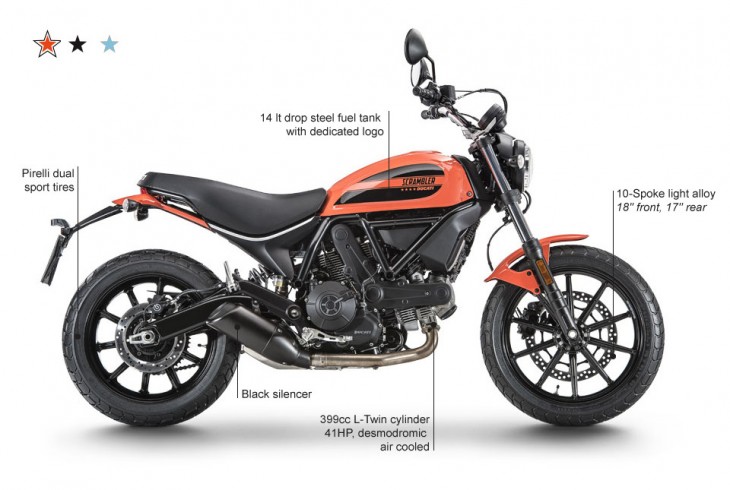
Main as-standard features:
Ducati Scrambler Sixty2
- Colours
- “Atomic Tangerine” with black frame and black seat
- “Ocean Grey” with black frame and black seat
- “Shining Black” with black frame and black seat
- Features
- Steel teardrop fuel tank with dedicated design
- Dedicated adhesive logo
- Traditional stanchion fork
- Newly designed front mudguard
- Classically designed steel swingarm
- Exhaust with all-new pipe layout and black silencer cover
- Rear wheel with 160/60 x 17’’ tyre
- Round rear view mirrors
- High plate holder
- 2-channel ABS as standard
Old school is the new school
The 80s-style logo draws its inspiration from motocross and BMX old school culture – the source of the stars icon.
These same stars would go on to become an icon of style, performance and, later, the emblem of the best old school BMX riders. This logo features 4 stars to represent the 400 cc engine.
Not just a style-based choice, then, but one closely connected with the bike’s identity: The Ducati Scrambler, in fact, mixes heritage and innovation, motorcycling and lifestyle.
So while the Ducati Scrambler 800 is aimed at motorcyclists that see riding as a form of escapism, the Sixty2 has been built to appeal to younger riders and their yearning for fun. The Sixty2, dedicated to the year in which the first Ducati Scrambler appeared, draws on youths who, eager to emulate their motorcycling heroes, modified their 20″ bicycles to create an all-new bike and an entirely crossover sport.

Bart & Betty
The story of Bart and Betty is one sparked by a one-to-one collision at the skatepark. Bart is a motorcyclist and tireless skater. He loves going out to practise at first light when the skatepark is an oasis surrounded by palm trees, a place to try out new tricks wrapped in silence and rocked by the cool sea breeze. Bart, up there on the ramp overlooking the beach, enjoys being on his own in his natural habitat.
Right up until the day Betty literally crosses his path: the day a “skate and freedom” session takes an unexpected turn.
Bart was treating everyone at the skatepark to something of a ‘trick show’ and was determined to complete a McTwist he’d been practising for weeks. The crowd was applauding and he was just starting to enjoy the taste of victory when, on the verge of completing a fantastic 540°, a BMX bike cut across his path and sent him tumbling to the bottom of the pipe. Bart’s rage melted away quickly as the rider unexpectedly turned out to be a beautiful girl. Answering to the name of Betty, she was cheeky, witty and, in order to break the ice, presented him with a challenge.
Bart, of course, made the most of a great opportunity to reaffirm his status as the idol of the skatepark (and the luckiest motorcyclist around) by roaring off on his Ducati Scrambler Sixty2 with Betty riding pillion.
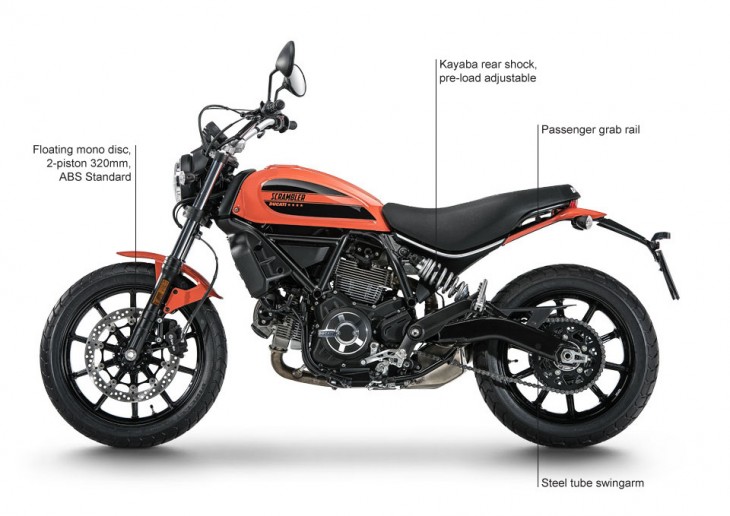
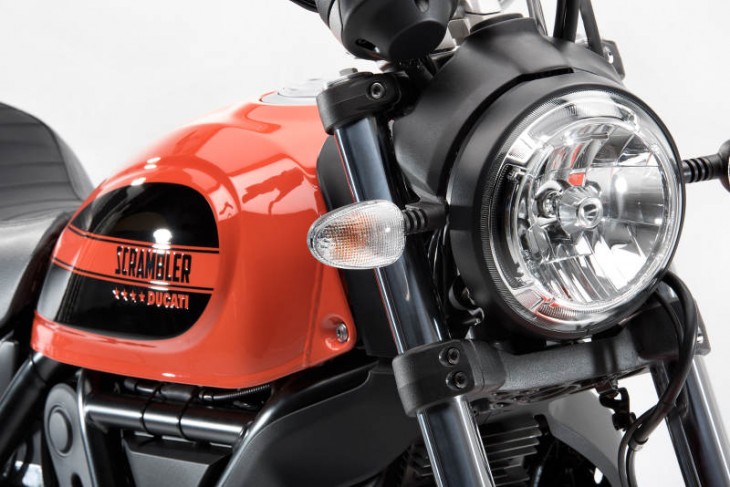
Premium essential style
With Sixty2 essential style becomes premium. The teardrop design of the tank is more essential than ever thanks to side panels with decals depicting this version’s characteristic logo.
The headlight, with glass parabola and LED light- guide around the perimeter (this acts as a side light), is the same as those installed on other Scrambler versions. The same is true for the full LED rear light.
On the Ducati Scrambler Sixty2, the essential design is highlighted by the exhaust pipe layout, which enables an even less hindered view of the Ducati twin-cylinder engine, the round mirrors and the high plate holder. Moreover, the matt black silencer cover gives the bike that extra touch of originality, accentuating the essential design of the new swingarm.
Everything on the Scrambler has been thought out down to the last detail, such as the beautifully cross-spoked alloy wheels that take their cue from the world of Flat Track racing. The filler cap, which bears the inscription “born free – 1962”, reflects the closure system in vogue in the 70s; similarly, the key, once inserted in the switchgear on the headlamp unit, recalls the design of the original light switch. Under-seat moulding provides another 70s design throwback.
Instrumentation
The instrumentation on the Ducati Scrambler Sixty2 consists of a single, round assembly positioned above and to the right of the headlight. While completely digital, the scale on the rpm indicator resembles the speedometer on the bikes of the 70s (i.e. positioned in the lower part of the instrument assembly). As engine revs increase the digits light up clockwise (right to left). Ducati Scrambler instrumentation also features two trip odometers and one total- mileage odometer, a trip fuel indicator, an air temperature display, maintenance reminders, a clock, and fuel reserve and ABS warning lights. Riders can also count on an engine oil pressure warning light, full beam indicator, neutral indicator, turn signal indicators, immobilizer and over-rev warning light.
Controls
Ducati Scrambler styling is also evident on the controls. The wide handlebars house a classic, wire- connected, twist-grip throttle together with an axial-pump front brake lever. Minimalist Ducati Scrambler design continues with the cable-actuating clutch lever. The switchgear is characterised by the now-standard yet exclusive “trigger catch” that slides down to cover the starter button when the kill switch is activated. It’s the same one used on all Ducati bikes, its high-tech design underscoring the unique style of the Ducati Scrambler.
The black painted die cast aluminium footrest plates support the gear change lever and the off-road type rear brake lever.
Engine
An air-cooled 399 cm³ L-twin, two-valve engine powers the Ducati Scrambler Sixty2. Derived from the engine on the Scrambler Icon it has a 72 mm bore and a 49 mm stroke. The Desmodue engine on the Ducati Scrambler has light, machine-finished aluminium covers, including those on the clutch and alternator.
As on the larger-engined version, the L- twin on the Scrambler Sixty2 features a single 50 mm throttle body with two sub- butterfly injectors: this solution ensures fluid power delivery and accurate control of the fuel being aspirated into the cylinders.
The twin-cylinder Scrambler Sixty2 is Euro 4 type-approved and has cast pistons with machined valve pockets while the crankshafts are of the single-piece type. The 2-in-1 exhaust with aluminium-covered silencer has been specially designed for the Ducati Scrambler Sixty 2 with the pipes offering a ‘low-slung’ look.
The gearbox is a 6-speed unit while the cable-actuated clutch emphasises the minimalist nature of the Ducati Scrambler.
The twin-cylinder Desmodue engine on the Ducati Scrambler Sixty2 has been designed to favour smooth running and fluid acceleration throughout the rev range, delivering 41 hp at 8,750 rpm and a torque of 34.3 Nm at 7,750 rpm. Designed to be simple and accessible, just like the Scrambler itself, it also features competitive 12,000 km maintenance intervals (every 7,500 miles).
Desmo delight
The Ducati Scrambler is iconic, as is the celebrated Ducati Desmo, the engine valve closure system that has made Ducati famous all over the world. Thanks to this system, the intake and exhaust valves are closed positively and precisely using a technique comparable to that employed to open the valves. The term desmodromic
stems from the Greek words desmos (link) and dromos (stroke); mechanically speaking, the term refers to mechanisms having a specific control to operate them in one direction (e.g. opening) and another which acts in the opposite direction (closure or return).
However, the desmodromic concept is not a recent one and has been used in the motorcycle and car industries for some time. It first appeared, in a variety of forms, way back at the start of the twentieth century. In 1956, the renowned engineer Fabio Taglioni set Ducati off along the desmodromic path: the first bike to feature the solution was the Grand Prix 125, which had three overhead camshafts, driven by a vertical shaft and a bevel gear. From that point on, desmodromic history became a Ducati exclusive and in 1968 the company started producing this timing system as standard with the Mark 3 Desmo 350. This milestone of a motorcycle essentially had the same timing system as current 2-valve twin cylinder engines like the one on the Ducati Scrambler, clear evidence of the concept’s soundness. Used on all Ducati models, the system is also employed on Ducati Corse’s Superbikes and Desmosedici MotoGP bikes.
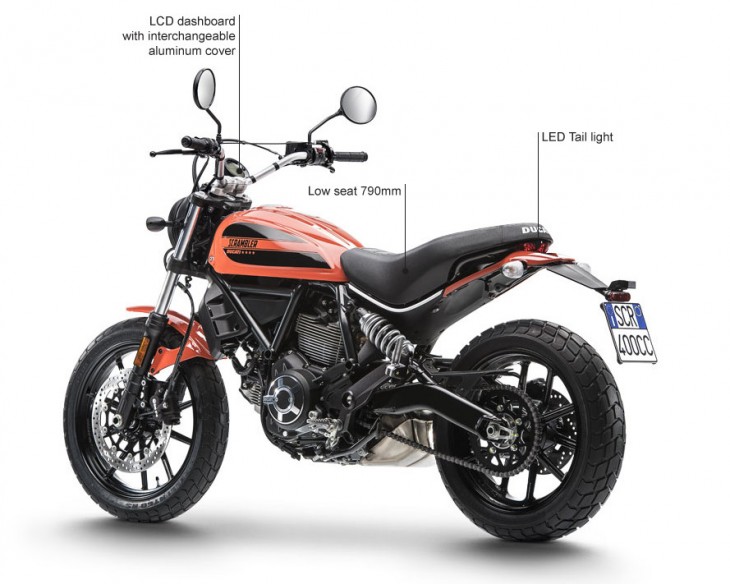
Chassis
Frame
The Ducati Scrambler features a twin upper spar steel Trellis frame. Essential and elegant, the Ducati Scrambler frame embraces the engine and extends beneath the seat, providing the sturdiness one expects from a real Ducati. Thanks to 24° of rake and 112 mm of trail, manoeuvrability is outstanding both in city traffic and on Alpine hairpins. Thanks to the wide handlebars, weaving your way through the urban obstacle course on a Ducati Scrambler is child’s play, while the 1,460 mm wheelbase maximises stability at high speeds. The Scrambler Sixty2 features an all-new steel Trellis swingarm.
The steel fuel tank, with that unmistakeable teardrop silhouette, has a capacity of 14 litres. With an excellent frame and outstanding chassis geometry, the Ducati Scrambler makes for relaxed riding that is easy yet fun. User-friendly and agile, the Ducati Scrambler is a source of endless satisfaction on both city streets and the open road.
Suspension
The Scrambler Sixty2 is equipped with a Showa 41 mm traditional stanchion fork (diameter not adjustable). At the rear, instead, the suspension consists of a Kayaba monoshock with adjustable spring preload. Both provide 150 mm of wheel travel, ensuring the tyres hug the ground whatever the terrain, from city streets to undemanding off- road routes. It is this mix of comfort and performance that makes the Ducati Scrambler unique, letting riders express themselves to the maximum everywhere and anywhere.
Wheels and tyres
All new aluminium 10-spoke wheels – clearly of flat-track origin – come as standard on the Ducati Scrambler. The design is a throwback to the days of thin, criss-cross spokes inserted in the hub. The 3″ x 18″ front wheel and the rear 4.5″ x 17″ one have been designed to be light and mount the new enduro-type Pirelli MT60 RS 110/80 R18 tyre at the front and the 160/60 R17 at the rear; featuring a chunky tread pattern, these tyres are produced exclusively for the Ducati Scrambler. The result is outstanding performance on surfaces of any kind.
Brembo braking system with 2-channel ABS
The Ducati Scrambler mounts Brembo braking featuring a Bosch 9.1 MP ABS system with an internal pressure sensor. To combine maximum stopping performance with minimalist styling, the front wheel has a single 320 mm disc with a 2-piston floating caliper. At the back, instead, a 245 mm disc is gripped by a caliper with a 32 mm piston.
